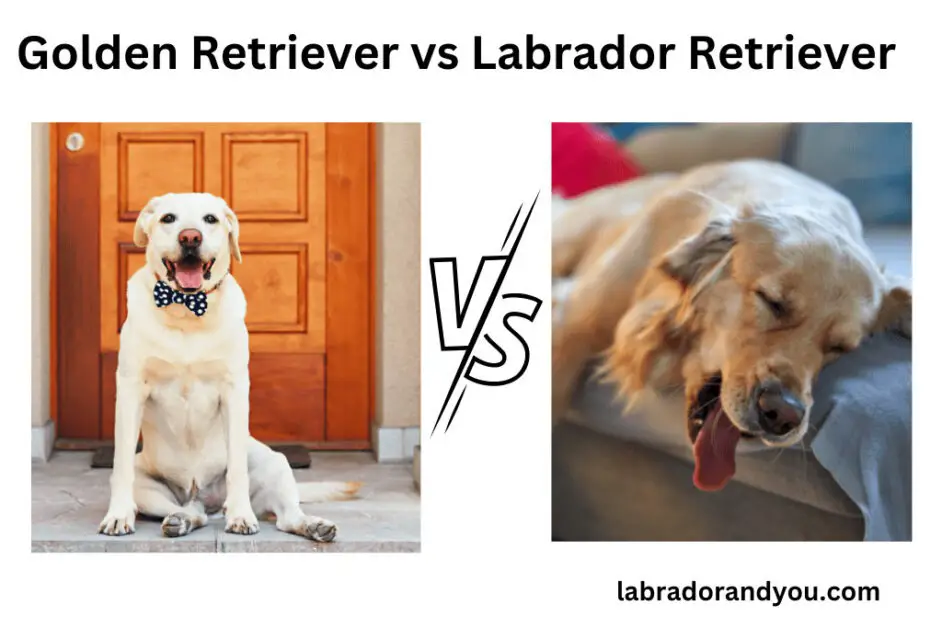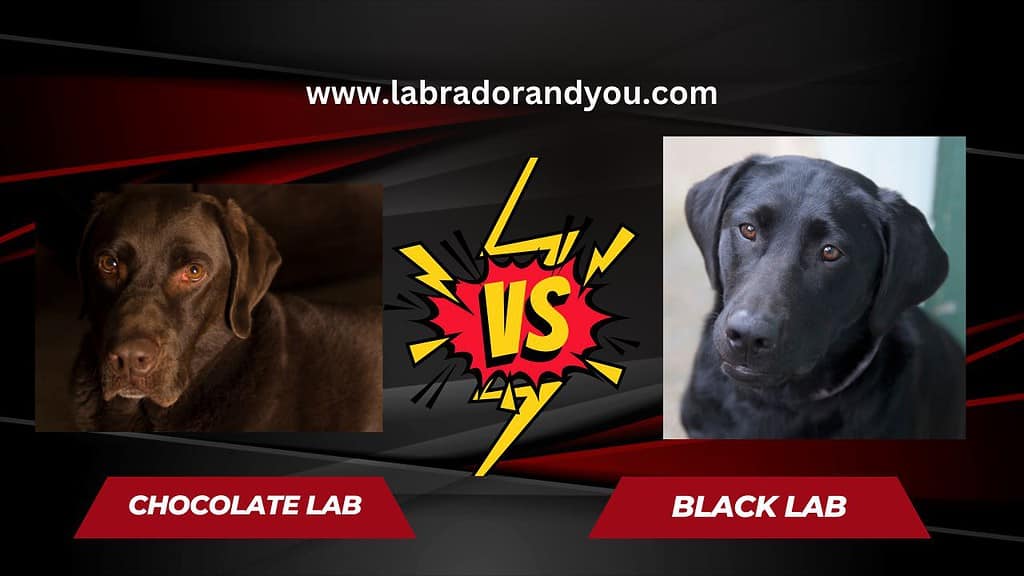Labrador Retrievers and Beagles are two popular dog breeds that differ in size, temperament, and origin. Both beagles and labradors are wonderful dogs that suit well in family settings. Labradors are larger dogs initially bred for hunting and retrieving games, while Beagles are smaller dogs. A labrador retriever is friendly, loyal, and outgoing, while Beagles are curious, energetic, and independent.
Labradors may be a better choice for families with young children due to their gentle nature. A beagle suits families willing to provide adequate exercise and attention.

Breed Overview: Beagle vs Labrador Retrievers
Both labrador beagle have unique qualities and personalities, making them great family pets for different lifestyles.
Labrador Retriever: A Versatile And Popular Breed
Labradors are well known for their versatility and are America’s favorite breed. They were originally bred as working dogs to assist fishermen in retrieving nets. Today, they excel as guide dogs for those with visual impairments. A service dog supports people experiencing physical challenges, and Labs excel at it. Their strong work ethic and sweet disposition make them valuable companions and helpers.
These large and muscular dogs have short, dense coats. It allows them to navigate through water easily – an important trait given their affinity for swimming. This love of water makes Labradors fun, especially for households that enjoy spending time at the beach. They have a friendly demeanor towards strangers and adapt quickly to new situations.

Beagle: A Small Dog With A Big Personality
Beagles are known for their big personalities despite their small size. They are full of life, spunk, and adventure and love to explore the world around them. They have a natural curiosity that can sometimes get them into trouble. With their keen sense of smell, Beagles were originally bred as hunting dogs.
Today, they have become beloved family pets. One of the most charming aspects is their joyfulness. They seem always to be wagging their tails, ready for whatever fun might come their way. This makes them great companions for families with active individuals.
Beagles also require proper training to prevent behavioral issues. They will be a loyal and adventurous addition to your family, keeping you on your toes.

Beagle Vs Labrador Retriever: Size And Weight
Labradors have short and dense coats requiring regular grooming. Beagles have a smaller frame with a less dense coat, needing minimal grooming. When comparing the size and weight of Labradors and Beagles, it’s easy to see the noticeable difference. Due to the beagle dwarfism, beagles are much shorter.
The Labrador Retriever is a larger breed. This difference in size and weight is crucial when deciding which breed may be a better companion for you.

Beagle Vs Labrador: Color And Texture
Both Labs and Beagles offer a variety of options that can suit your aesthetic preferences. Let’s examine the differences in the table below:
| Coat Characteristics | Labrador Retriever | Beagle |
|---|---|---|
| Coat Color | Beagles have a wide range of colors and patterns, including white, black, tan, red, and more combinations. | Beagles also have short coats but are less dense than a Labrador Retriever. |
| Coat Texture | Short and dense | Beagles also have short coats but are not as dense as a Labrador Retriever. |
| Shedding | Labradors shed frequently, particularly in the spring and fall. | Beagles shed moderately throughout the year. |
| Grooming Requirements | Labradors require regular brushing to minimize shedding and maintain a healthy coat. | Beagles also benefit from regular brushing, but their grooming needs are generally lower compared to Labradors. |
Beagle Vs Labrador: Temperament And Personality
Labrador temperament is active and affectionate. They’re loyal pets that love spending time with their owners. They enjoy playing fetch or going on long runs. Beagles are curious dogs that like to explore their surroundings on their terms.
They can sometimes be stubborn. Both breeds require attention and training to ensure they get along with other pets. Labs thrive on human interaction and need heavy exercise. Beagles enjoy having space to roam freely.
Beagle Vs Labrador: Exercise And Training Needs
Labradors are high-energy dogs that need regular exercise. They thrive on long walks, runs, swimming, and playing fetch in a large yard or open space.
Beagles enjoy outdoor activities like hiking and running but are content with shorter walks. Training is essential for both breeds. Labs are generally easier to train since they want to please their owner. Obedience training is easy.
A Beagle can be more challenging. Their independent streak often leads them astray when distracted by scents or prey animals. They can be great in scent work. Consistent training from an early age ensures success for both breeds.
Health Concerns, Lifespan, And Choosing The Right Breed
Health Issues
- Hip Dysplasia and Elbow Dysplasia: Both breeds can develop elbow and hip dysplasia. It is an inherited condition that causes the hip joint to develop abnormally. This can lead to arthritis and lameness ( hip dysplasia)
- Obesity: Both breeds are also prone to obesity. Especially if fed a diet high in calories and not given enough exercise.
- Ear Infections: Beagle has floppy ears that can trap moisture and debris, leading to ear infections.
- Skin Allergies: Both breeds may develop skin allergies which result in excessive itching or scratching.
- Eye Problems: Labradors are prone to cataracts and progressive retinal atrophy. Beagles are susceptible to glaucoma and cherry eye.
- Bloat: Labs and Beagles have deep chests, which puts them at risk of developing bloat. The stomach twists on itself and cuts off blood flow to vital organs in this life-threatening condition.
- Dental Problems: Both breeds may experience dental problems like tartar buildup or gum disease if proper oral hygiene is not provided.
Average Lifespan For Each Dog Breed
The average lifespan of a Labrador Retriever is around 10-12 years. The average for Beagle is between 12-15 years. Proper exercise regimes and nutrition are essential to increase the lifespan of both breeds. You can ensure they live longer by being proactive with their healthcare needs.
Beagle Vs Labrador: Choosing THE ONE
First, consider indoor/outdoor space, activity levels, and grooming tools. A Beagle may be better if you live in an apartment or have limited outdoor space. This is due to its smaller size and exercise needs.
A Lab might suit you if you have plenty of room and enjoy long walks outdoors. Another important consideration is temperament. While both breeds are friendly, Labradors are more outgoing with strangers than Beagles.
Labs also make excellent guide dogs, while Beagles are natural hunters. Finally, evaluate potential health concerns for each breed, like obesity issues in Labs or epilepsy in some Beagles. It’s all about finding the right balance of traits that match your lifestyle and personality preferences.

Keeping Your Dogs Healthy And Happy
Beagle Vs Labrador Retriever: Canine Intelligence
Labrador Retriever is intelligent and trainable, making them excellent guide and search-and-rescue dog. Training them is relatively straightforward. Positive reinforcement methods like rewarding good behavior with treats or praise work. Beagles also possess above-average intelligence but can be more challenging to train.
Establish yourself as the pack leader early in your Beagle’s life and use consistent reinforcement techniques. Training sessions should be kept short and engaging. Tailor your approach based on what works best for your furry companion to reach its full potential!
Activity Requirements: Keeping The Dog Breeds Active And Engaged
Keeping your dog engaged is important for their physical and mental well-being. Here are some tips on how to keep your Labrador or Beagle active:
- Walks: Take your dog on daily walks to get them moving, explore new surroundings, and stimulate their senses.
- Playtime: Both breeds love to play! Try playing fetch with a ball, frisbee, hide-and-seek, or tug-of-war.
- Swimming: Labradors have a natural affinity for water, while Beagles may need some encouragement initially. Consider taking your dog swimming in a pool or lake to give them low-impact exercise.
- Agility Training: These dog breeds are smart and enjoy challenges. Set up an agility course in your backyard, or take them to a local training facility.
- Hiking: Bring your dog on hikes if you enjoy the great outdoors. Both breeds have high energy levels and love exploring nature. Ensure they have access to plenty of water before, during, and after exercise.
Beagle Vs Labrador Dogs: Behavioral Issues And How To Manage?
Labradors and Beagles can exhibit behavioral issues like excessive barking, chewing, and digging. Provide your dog with plenty of exercises and mental stimulation to manage these issues. Labradors require more daily exercise than Beagles due to their larger size and energy levels.
To prevent destructive chewing, provide your dog with plenty of chew toys. It will redirect their attention away from household items. Consider using a bitter-tasting spray on the affected areas if your dog continues to chew on inappropriate objects.
Barking is a common behavioral issue for both breeds. It is a form of communication or territory marking. Excessive barking may indicate boredom or anxiety. Providing ample physical activity can help reduce barking. A consistent training routine can teach them when it’s appropriate to bark.
Beagle Vs Labrador Dogs: Nutrition Requirements
Here are some important tips to keep in mind:
- Feeding: Both breeds have different metabolic rates and dietary needs. Choose high-quality dog food for their age, size, and activity level.
- Water: Ensure your dog has access to clean water.
- Treats: Moderation is key when treating your dog. Too many treats can lead to obesity and other health problems.
- Grooming: Regular grooming can help keep your dog’s coat healthy and shiny. Weekly brushing of a labrador removes loose hair and prevents matting.
- Bathing: Frequent baths are needed. Usually, every two to three months, use a mild dog shampoo.
- Nails: Keep your pet’s nails trimmed regularly. If you hear them clicking on the floor, they’re too long.
- Teeth: Dental hygiene is essential to prevent dental problems such as tartar buildup, bad breath, and gum disease. Brushing your pet’s teeth regularly is recommended by veterinarians.

FAQS
Which breed is better, Labrador Retriever or Beagle?
Both labrador beagle breeds are highly energetic dogs and will ask for your time. Beagles are smaller, while labradors are large dogs. Both have a hunting background.
Are Beagles good with a Labrador retriever?
The Beagle breed is a suitable option for labradors. Beagles find it easier to get along with any dog breed. If you want to pair a Beagle with a Labrador retriever, pair a male with a female of either breed.
Does a Lab shed more than a Beagle?
A labrador retriever breed sheds more than a Beagle breed. Beagles shed, but their short hair makes it less noticeable. Labradors are heavy shedders compared to Beagles.
Which is better Beagle or golden retriever dog breed?
The small-sized Beagle is better suited for apartment living than a Golden Retriever. Training a Golden is easy, as Beagles can get stubborn sometimes. Golden retrievers shed more than Beagles and need regular brushing.
Do Beagle dogs bark a lot?
Beagles that are left alone too much can develop behavioral issues like excessive barking. Other traits include anxiety and destructive tendencies.
How much do Labrador and Beagle puppies cost?
Puppy prices for the beagle and labrador range from $ 1000 to $ 3000 from reputable breeders with American kennel club papers. Dogs from the championship line can cost more than $ 3000. Rescue centers charge about $ 300-$500 for adoption.
do beagles shed as much as labs?
No, beagles do not shed as much as Labrador Retrievers. Both breeds are moderate shedders, but Labrador Retrievers are known for their heavy shedding during seasonal changes. Beagles, on the other hand, shed more evenly throughout the year. Beagles have a short, dense double coat, while Labrador Retrievers have a short, single coat. This means that beagles have a shorter undercoat, which sheds less than the longer undercoat of a Labrador Retriever
Author Profile

- Lifetime dog Enthusiast
- Shradha is a seasoned writer at Labradorandyou.com, an authoritative resource for all things Labrador Retriever. Her experience as a pet owner and dog enthusiast drives her to create meticulously researched and fact-checked content, offering valuable insights on Labrador training, grooming, and health. Each article reflects Shradha's passion and dedication, enriched by personal experiences with her beloved Labradors, Tom, and Kurt. Whether exploring breed-specific training techniques or providing product reviews, Shradha ensures Labrador owners receive the most accurate, up-to-date, and trustworthy information, aimed at enhancing their companions' health and happiness
Also by the author
-
 vulkan vegas germanyJune 26, 2025Vulkan Las Vegas Bonus Code In Nessun Caso 2025
vulkan vegas germanyJune 26, 2025Vulkan Las Vegas Bonus Code In Nessun Caso 2025
-
 mostbet hungaryJune 26, 2025Legális Magyar On The Web Kaszinó Nyerőgépek És Asztali Játékok Széles Választéka A Grandcasino Hu-n”
mostbet hungaryJune 26, 2025Legális Magyar On The Web Kaszinó Nyerőgépek És Asztali Játékok Széles Választéka A Grandcasino Hu-n”
-
 casinoJune 26, 2025Pin Up Login E Registro Acesso Rápido Ao Gambling Establishment Pinup
casinoJune 26, 2025Pin Up Login E Registro Acesso Rápido Ao Gambling Establishment Pinup
-
 Lab-TypesJune 26, 2025Pin Up прохода В Личный кабинетик Регистрация В Казино Пин Ап
Lab-TypesJune 26, 2025Pin Up прохода В Личный кабинетик Регистрация В Казино Пин Ап





